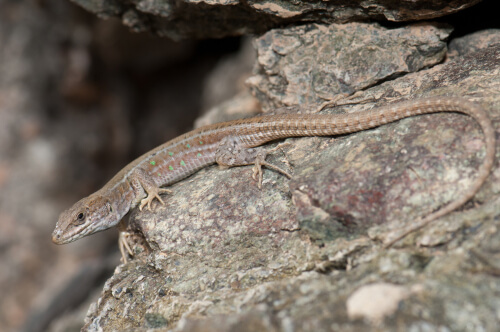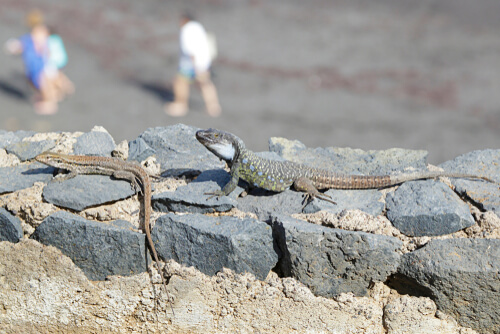How Do Lizards Regenerate Their Tails?


Written and verified by the biologist Cesar Paul Gonzalez Gonzalez
Some lizards have a strategy called caudal autotomy, which consists of detaching their tails in order to escape from predators. This allows them to leave a juicy meal for their enemies while they escape to safety. Because this defense mechanism is so important and efficient, we can also find that lizards regenerate their tails so that they can use them as decoys on another occasion.
This curious ability is very distinctive in several species of lizards, geckos, and salamanders. In addition, it has attracted the attention of several specialists due to the regenerative capacity involved in the process. Continue reading and you’ll learn how lizards regenerate their tails after caudal autotomy.
How do lizards shed their tails?
Autotomy is a curious process that consists of the separation of muscles, blood vessels, and vertebral bones to detach the tail and use it as bait. To do this, the lizards don’t need to “tear off” the structure themselves; their body is designed in such a way that right at the base of the tail everything is already separated.
The process is facilitated by the existence of “fracture planes”, which separate different sections of the tail transversely. Because of these, only a slight exertion is needed in order for the structure to amputate without causing significant damage to the lizard. In fact, according to an article in the Journal of Experimental Biology, the blood flow to the tail is also stopped, preventing fatal exsanguination.

Does it really do them any good to shed their tails?
It may seem implausible that simply amputating their own tail would increase the survival rate of a species. However, this is quite possible and evidence backs it up. As soon as the tail is detached, it continues to move as if it were a living being. Thanks to this, the predator is attracted to the “bait” and the reptile has enough time to escape.
However, it’s quite a costly process for lizards to endure, as the tail is very useful in balance, mating, and resource storage. This means that it must be employed as a last resort or it could become a death sentence for the reptile.
How do lizards cope with the loss of the tail?
The loss of the tail gives lizards an immediate benefit to escape from predators. However, this structure is important in their lives and they need to recover it to avoid difficulties when moving, mating, or just generally surviving. And, due to an impressive regeneration mechanism, their bodies allow them to “rebuild” it. The only problem is that it has a great energetic cost.
The process by which lizards regenerate their tail is incredible, as they rebuild their entire limb without having a “mold”. This process is very similar to what happens during embryonic development with stem cells. For this reason, it has been one of the most popular topics in scientific research.
The mechanism behind regeneration
The tail is regenerated by muscle satellite cells, whose function – in any organism – is to repair damaged tissue. In lizards, this cell lineage is able to “turn on” extra genes and rebuild more than just muscle. This process is also known as dedifferentiation and is what allows regeneration.
In a very general way, what satellite cells do is “retrieve” genes from the embryonic state to “guide” it. This gives them detailed instructions on how to rebuild the tail, which includes nerves, blood vessels, muscles, and epidermis.
Regeneration is a very complicated process and its mechanism isn’t yet fully understood. However, according to an article published in Developmental Biology, it has been estimated that about 326 different genes are involved. Each one is involved in different signals and different activities, and so it’s very difficult to establish the pathways of interaction and to solve the mysteries of its mechanism.

The tail doesn’t return to what it was
Although the regeneration process produces a new tail, it never reaches the same level as the first one. This is because the satellite cells don’t have sufficient capacity to function as a stem cell. Therefore, a functional structure is generated, but with obvious differences.
Regenerated tails may go unnoticed to the naked eye, as they usually have the same external colors and textures as the rest of the body. However, their composition changes and it has the following characteristics:
- Calcified cartilage tube: Vertebrae that were lost during caudal autotomy regenerate not as bone, but as a hardened (calcium-containing) unsegmented cartilage tube.
- Rudimentary muscle: The muscle fibers are reconstructed without the original complexity and arrangement. This doesn’t have a major impact on their function.
- Shorter nerves: Regeneration causes the nerves to be smaller in size. However, it also creates more of them, and this helps prevent the loss of tail movement.
Although lizards don’t regenerate their tails perfectly, caudal autotomy is a desperate, but necessary, measure that has proven to be quite beneficial. All in all, it only takes about 60 days to re-produce the lost structure, and so using it as bait and a distraction is a good investment in order to survive to see another day!
All cited sources were thoroughly reviewed by our team to ensure their quality, reliability, currency, and validity. The bibliography of this article was considered reliable and of academic or scientific accuracy.
- Clause, A. R., & Capaldi, E. A. (2006). Caudal autotomy and regeneration in lizards. Journal of Experimental Zoology Part A: Comparative Experimental Biology, 305(12), 965-973.
- Gilbert, E. A., Payne, S. L., & Vickaryous, M. K. (2013). The anatomy and histology of caudal autotomy and regeneration in lizards. Physiological and Biochemical Zoology, 86(6), 631-644.
- Bateman, P. W., & Fleming, P. A. (2009). To cut a long tail short: a review of lizard caudal autotomy studies carried out over the last 20 years. Journal of zoology, 277(1), 1-14.
- Ananjeva, N. B., Gordeev, D. A., & Korost, D. V. (2021). The review of the autotomy of agamid lizards with considerations about the types of autotomy and regeneration. Journal of Developmental Biology, 9(3), 32.
- García-Rosales, A., & Martínez-Coronel, M. (2016). Frecuencia de pérdida de la cola en un ensamble de lagartijas de Oaxaca, México. Acta zoológica mexicana, 32(2), 174-181.
- Palade, J., Djordjevic, D., Hutchins, E. D., George, R. M., Cornelius, J. A., Rawls, A., … & Wilson-Rawls, J. (2018). Identification of satellite cells from anole lizard skeletal muscle and demonstration of expanded musculoskeletal potential. Developmental biology, 433(2), 344-356.
- Cooper, W. E., Pérez-Mellado, V., & Vitt, L. J. (2004). Ease and effectiveness of costly autotomy vary with predation intensity among lizard populations. Journal of Zoology, 262(3), 243-255.
This text is provided for informational purposes only and does not replace consultation with a professional. If in doubt, consult your specialist.